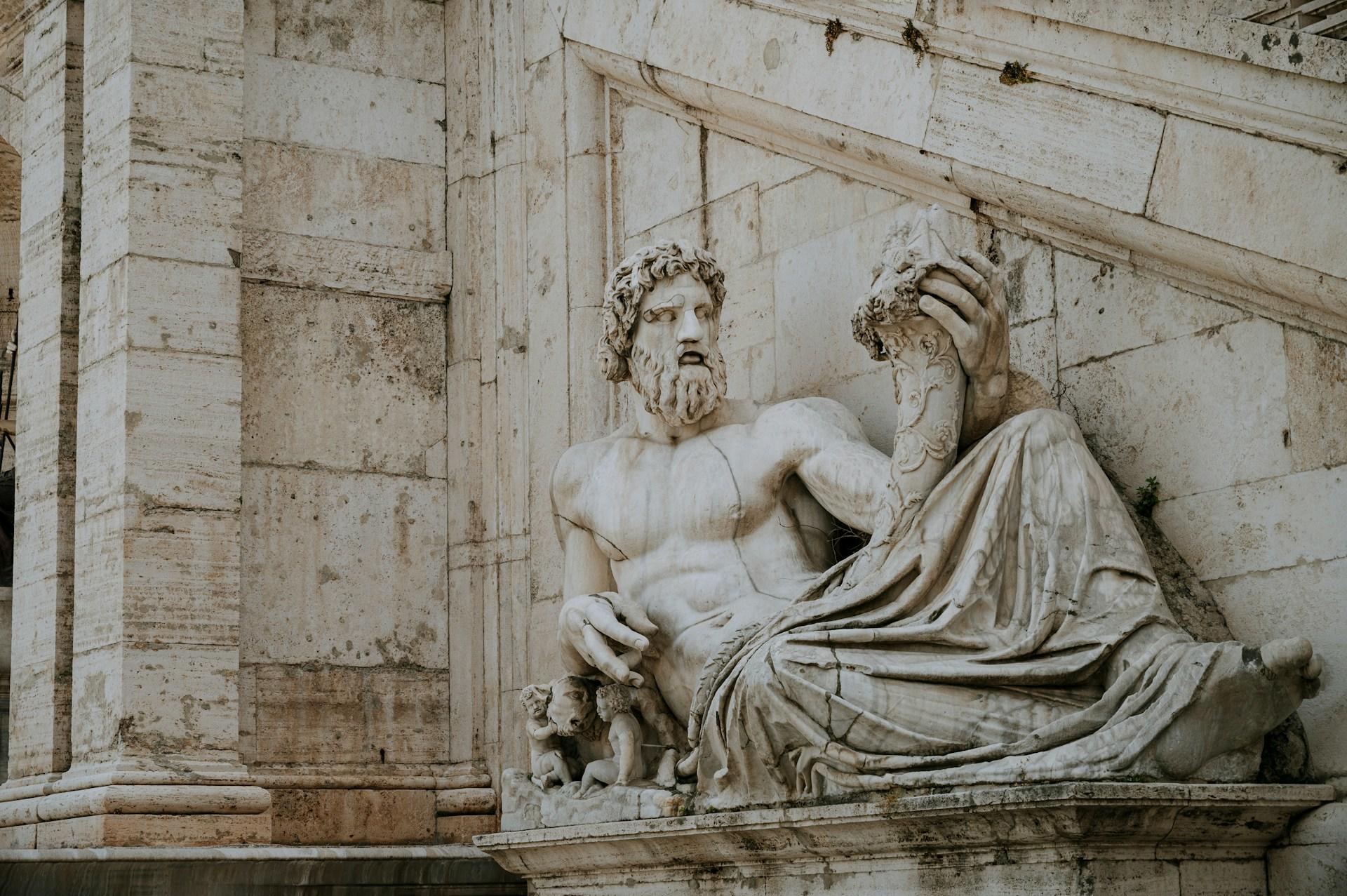Sculpture like archaeology: You dig in and you find something.
Georg Baselitz
Sculpture is perhaps the oldest art form in art history. That could simply be because other forms of art don't stand the test of time that well. Paintings, even the famous Lascaux Cave drawings, lose their colours quickly when exposed. China's Terracotta Army is mostly devoid of colour for the same reason.
In this article, we study pivotal moments in art, and the famous sculptures from history that provoked them. We discuss how they created an inflection point, and what happened in sculpture's evolution.
Pre- to Ancient history
Any discovered artworks that date prior to 3 000 BC
3 000BC to 325CE
Ancient cultures
Egyptian, Sumerian, Greek, Roman, Asian
325CE to ~1490s
Christian, Medieval Sculptures
Byzantine, Carolingian, Ottonian; Romanesque and Gothic
1300s to 1500s
Italian Renaissance
Return to classical sculpture; Mannerism, Baroque, Rococo, a return to Neo-Classical
Late 1800s
Modernism
The Thinker becomes the new sculpting style.
Today
Contemporary styles
Kinetic, assemblage, land, and other techniques emerge.

When Was The First Sculpture Made?
Löwenmensch (Lion Person)
To date, the oldest sculptures found were carved during the last of the Palaeolithic period. Two of the oldest works came to light in the South German region. The oldest is Löwenmensch, a sculpture of a person with the head of a lion, that you see above.
Venus of Willendorf
We find the intriguing possibility that this Venus is one of the world's earliest self-portraits. This carving presents a perspective a woman might see as she looks down at herself, a pose which would obscure her face.
This theory also posits that women were among the earliest sculptors. This idea is exciting, considering how devoid of female artists the historical record is!
We can't know the inspiration or purpose of these carvings. Researchers suspect sexuality and fertility may be at the heart of their creation. Other theories postulate a religious significance. Both carvings present universal religious themes, particularly the half-man, half-animal Löwenmensch.
Some might dispute these carvings being any kind of sculpture. Such a stance requires a very narrow definition of what this art form is, and it's a petty argument, anyway. Nobody in my art classes Melbourne would even entertain the question.
Where Did Sculptures Originate?
Typically, Western scholars consider Antiquity the true beginning of sculpture as an art form. Ancient Greece, Egypt and Rome get heavy credit. Mesopotamian sculpture gets far less attention, and East Asian sculptures get none. In fact, the pages we used for reference fail to mention Sumerian sculpture, and make no mention of China's exquisite jade carvings.
That might be because most Sumerian sculpted artworks were decorative. They did not seem to carry any religious significance, nor did they commemorate any great battles. For the record, most of the tablets were bas-relief carvings.
Nergal
Sculptors in Ancient Greece, Egypt, and Rome, more than made up for the Sumerian lack. Greek, Roman, and Egyptian lands were full of materials ideal for carving. By comparison, Mesopotamia lacked deposits of stone, which kept them from creating towering sculptures.
We know a lot about the boom in art production between 4 500 BCE (Before the Current Era) and the end of the Roman Empire. It’s a little lazy to lump all of this geographical, stylistic, and thematic diversity under one title. Yet, these Classical periods are when sculpture began to look like actual people or things.
Ancient Egyptian
At this point, we see the movement away from simply spiritual or ritualistic themes, to more secular representations. In Egypt, during this period, sculpture became a symbol of status and power. The more colossal, the more the idea of might is presumably conveyed.
This theory helps explain why pharaohs' statues grew ever bigger. Ramses II, also called Ramses the Great, demonstrated his power through immense statuary. The massive pair of statues in his likeness, the Colossi of Memnon, still guard Amenheotep's III mortuary temple.
Great Sphinx of Giza
Everything about the Sphinx is under question, save for its impressive dimensions, and the type of stone. Archaeologists debate its original intended representation - a guardian, a deity, or some other, as-yet unimagined creature or purpose.
They're even are at a loss to explain why the nose was chiselled off. All we can be sure of is that this massive work inspired other ancient cultures.
Hellenistic and Roman Sculpture
The period between 450 and 400 BC is known as the zenith of Greek sculptural culture. With increasing science knowledge, of anatomy, physiology, and motion, the Ancient Greeks developed new sculpting techniques and skills. Greek sculpture from this period is notable for attending closest to the human figure.
Victorious Youth
Lysippos was a prolific in creating sculpted art, but Phidias was one of the most influential and important of Greek sculptors. His statue, Zeus at Olympia, represented the pinnacle of Ancient Greek statuary. Unfortunately, nothing remains of Phidias' work. However, rediscovering his workshop took us a long way toward understanding this period in art and sculpture history.
Roman sculptors learnt everything about sculpting from the Greeks, and the Etruscans, who also adopted Greek stylings. Roman sculptures introduced lavish touches, but closer study reveals that Greek sculptors living in Rome created them. Only one full-sized, nearly complete statue of certain Roman creation exists.
Gaius Vibius Trebonianus Gallus

Early Christian Sculpture
With the acceptance of Christianity, towards the Roman Empire's end, sculptural traditions in Europe waned. This was in part due to the religious edict that forbade graven images.
Instability across Europe also contributed the destruction of religious icons, and forbade most medieval sculptures. In Northern Europe – in Scotland and Britain, and Scandinavia, the tradition of erecting massive stone carvings continued.
These different sculptural styles remained safely outside the church's list of forbidden themes. They were often crosses or, in Scandinavia, rune-inscribed.
Medieval sculpture is defined by its relation to Christianity. It adorns churches, tombs, and other religious structures.
The two styles that are most recognisable today from this period are Romanesque – which drew heavily on Greek and Roman sculpture – and Gothic. The latter emerged in France, and followed the Romanesque style. Both were important in laying the ground for the sculptors of the Renaissance.
Chartres Cathedral statuary
The Chartres Cathedral statuary represents a return to naturalistic figure representation. During the Romanesque period, about 1 000 CE (Current Era) to 1 200 CE, vividly-coloured sculptures began to appear.
Royalty - and, later, higher clergy members, began commissioning statues of themselves. Obviously, they preferred their sculpted images to be dignified, hence the shift towards naturalism. Thus, once again, the art world embraced the basics of sculpture.
Sculpture During the Italian Renaissance
If you're taking art classes Sydney, you've probably heard the mantra that the Renaissance period was history’s peak of artistic and literary culture. That's only true if you add the 'latest' qualifier, as in: "the Renaissance was the latest peak of...".
Renaissance artists and sculptors made the most of past sculptors' influence and ideas. Greek and Roman artists had moved sculpture away from religious imagery, and towards the human figure. Renaissance sculptors did the same.
David
Donatello and Michelangelo were equally knowledgeable about human anatomy, and turned out life-like, proportional statues. They both sculpted versions of David. They, alongside Leonardo da Vinci and Raphael, rank among the Renaissance Masters. This period's explosion of artwork gave us some of the most famous sculptors in history.
In due time, the Renaissance period gave way to other stylings. Some art historians contend it was a short-lived era, which the Mannerist movement supplanted in 1512.
Others argue that the Baroque, Rococo, and Neo-Classical stylings unseated Renaissance sensibilities. They also point to the early 16th Century as marking the Renaissance's end. Those arguments notwithstanding, Mannerism became the next big evolution in sculpted art.
Rodin: The First Sculpture in Modernist Style
By the turn of the twentieth century, Modernism dominated the art world. This style came from a desire to create new artistic and cultural expressions. In sculpture, the person who did this best – and most influentially, was Auguste Rodin.
The Thinker
Rodin sought to make the sculpture more impressionistic. His work was more 'realist' than the previous sculptural trends, which focused on religious or mythical figures. Rodin's work so revolutionised the art world that one of the great sculpture museums bears his name.
What are Statues Made of in the Twentieth Century?
Twentieth-century sculpture continued along Rodin's path. Like him, sculptors adopted different ideas about what art and sculpture could be. Throughout the century, sculpture became more abstract, more simple, and more symbolic. Artists concerned themselves with movement and shape, with light and dark, and different materials.
Fountain
Artists and critics alike rose up in outrage at Duchamp's seeming vulgarity. Nonplussed, he stood by his creation, and it went on to stand the art world on its head. Unlike for other famous Dadaists - Picasso, Giacometti, and Brancusi, commissions flooded in for replicas of Duchamp's work.
You will learn these and other facts about sculptures in your art classes. You'll also discover that the possibilities open to contemporary artists are endless. The lines between different art forms blur continuously. This diversity is contemporary sculpture's beauty.















